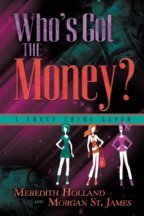Using Life Experiences (Part 1) by Morgan St. James #GuestPost #writertip
 Morgan St. James is an award winning multi-published author, speaker and columnist. She has written over 500 published articles relative to the craft of writing and people in the industry, as well as the book Writers’ Tricks of the Trade: 39 Things You Need to Know About the ABCs of Writing Fiction.
Morgan St. James is an award winning multi-published author, speaker and columnist. She has written over 500 published articles relative to the craft of writing and people in the industry, as well as the book Writers’ Tricks of the Trade: 39 Things You Need to Know About the ABCs of Writing Fiction. Today and tomorrow, she shares with us her tips on using Real Life Experiences in your writing.
How to relate life experiences to your writingEven if you feel as though there was nothing really special about your journey along the path of life, you would be surprised at the treasures you can find if you open your mind and explore. Life experiences and emotions are priceless when writing fiction, creative non-fiction and yes, memoirs even if there is no story that seems worthy of a book. Two perfect examples of captivating memoirs from ordinary women are “Dancingin My Nightgown: The Rhythms of Widowhood,” by Betty Auchard and “CanWe Come In and Laugh, Too?” by Rosetta Schwartz, my mother.
Betty, married to the love of her life for many years, depended upon him for everything. Now she has to learn to cope after he dies, and it wasn’t easy. She takes you through the steps of emerging as an independent woman after years of being half of a couple, deftly telling the tale of her struggles and triumphs. A story many women can relate to. Rosetta, who was born in 1909, tells of being the youngest in a zany family of ten children when the world was so different. She takes you all the way through to 1989 when, at the age of 80, she wrote her story. Rosetta, too, faced challenges in life and always depended upon what she learned as a child growing up in a family with more laughter than money. The title of her book says it all. The neighbors always used to knock on the door and ask if they could come in and laugh too. She looked at bumps in the road with laughter and taught her whole family to do the same. She inspired people to believe in themselves.
Then there are memoirs like “TheButterfly Garden: Surviving Life on the Run with One of America’s Most Wanted,”by Chip St. Clair, the horrific story of growing up in total fear. As a boy, he never knew what would set his father off--maybe the ice cubes had melted in his glass of Tab, maybe dinner was overcooked or undercooked or the gravy was too runny. Regardless, the beatings always came. As did the twisted games of cat and mouse--being thrown from a rowboat into frigid Lake Michigan, the middle-of-the-night moves to different states, or being left to dangle over a ten-story balcony while his father watched from inside. Somehow he tells it all in a way you can understand right through to the point where as an adult he becomes an advocate for abused children.
ONE OF THE MOST IMPORTANT QUALITIES A FICTIONAL CHARACTER CAN POSSESS IS TO SEEM REAL TO THE READER. Keeping this in mind, your own experiences can be used to breathe reality into fictional characters. Forget just stringing together a series of words describing physical attributes and how the character carries out routine or off-the-chart situations—perhaps spiced with inner thoughts. There is more to creating someone with feelings and emotions and a physical presence. Doing that doesn’t have to be daunting. The reader sees events through the eyes of these players in the story, so at all costs avoid moving paper dolls or overblown figures through the scenes. Here is where the advice, ‘draw from what you know,’ comes into play.
PUTTING LIFE INTO PHYSICAL DESCRIPTIONSThis is a place where adjectives, adverbs, similes and metaphors are your friends as long as they aren’t overused. Sprinkling them in the right places sparks the reader’s imagination. It allows them to draw parallels to familiar images and see them in their mind’s eye. Overuse them, however, and it minimizes everything. Why? Because with each new spouting of a simile, metaphor or more adjectives or adverbs than should ever be huddled together in the same sentence, the reader begins wonder how many more of these they can endure.
TAP INTO YOUR OWN IMPRESSIONS RATHER THAN CLICHÉSTo avoid clichés, reach into your own experiences and picture things that impressed you. Put the image into words and apply it to something about your character. For example, the woman had shining blonde hair. If it was straight, did it just hang there or shimmer like a golden shawl? Why would I choose the simile of a golden shawl for this example? Because I pictured a former business partner and friend who had hair like that. I could never look at her without thinking of a golden silk shawl. Let’s say the hair isn’t straight, but curly. Is it in tight ringlets perhaps described as coiled little ringlets like the fur on a pampered poodle? Maybe this blonde hair undulates in luxurious waves reminiscent of waves kissed by the glow of the sun as they push toward shore. In each of these examples we picture a different person. And, every reader will have their unique vision of that person. Simply saying “her straight blonde hair” or “curly blonde hair” would never launch imagination in the same way.
CREATING YOUR OWN REFERENCE FILE
 So often these images are fleeting, triggered by something someone said, something we remembered or saw, but even with Herculean effort, we can’t pull them back when we need them. They lurk right at the edge of recognition, then slip away. One way to capture them is to keep a log. When an image like that pops into your mind, distinct images and emotions ride on their coattails, leaving you with a describable impression. Reach for the little spiral notebook—we all should have one of those—and flip to the section you’ve set aside for just such visions. Using the same example as above, assume you imagined hair badly in need of care. Maybe you would jot down: her blonde hair reminded me of a field of hay long past the time it should have been harvested.
So often these images are fleeting, triggered by something someone said, something we remembered or saw, but even with Herculean effort, we can’t pull them back when we need them. They lurk right at the edge of recognition, then slip away. One way to capture them is to keep a log. When an image like that pops into your mind, distinct images and emotions ride on their coattails, leaving you with a describable impression. Reach for the little spiral notebook—we all should have one of those—and flip to the section you’ve set aside for just such visions. Using the same example as above, assume you imagined hair badly in need of care. Maybe you would jot down: her blonde hair reminded me of a field of hay long past the time it should have been harvested.
Morgan has recently published: The Mafia Funeral and Other Short Stories Vanishing Act in Vegas – The third silver sisters mystery Who's Got the Money? Writers Tricks of the Trade: 39 Things You Need to Know About the ABCs of Writing Fiction
What are some of the life experiences you've written about? read about? Were the scenes more realistic because of your personal experience? Leave a question for Morgan in the comment section, and come back Friday for Part II.
Published on September 10, 2012 00:00
No comments have been added yet.



